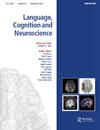量词验证过程中计算复杂度与记忆负荷的相互作用
IF 1.8
3区 医学
Q2 AUDIOLOGY & SPEECH-LANGUAGE PATHOLOGY
引用次数: 0
摘要
本文章由计算机程序翻译,如有差异,请以英文原文为准。
The interplay of computational complexity and memory load during quantifier verification
ABSTRACT Formal analysis of the minimal computational complexity of verification algorithms for natural language quantifiers implies that different classes of quantifiers demand the engagement of different cognitive resources for their verification. In particular, sentences containing proportional quantifiers, e.g. “most”, provably require a memory component, whereas non-proportional quantifiers, e.g. “all”, “three”, do not. In an ERP study, we tested whether previously observed differences between these classes were modulated by memory load. Participants performed a picture-sentence verification task while they had to remember a string of 2 or 4 digits to be compared to a second string at the end of a trial. Relative to non-proportional quantifiers, proportional quantifiers elicited a sentence-internal sustained negativity. Additionally, an interaction between Digit-Load and Quantifier-Class was observed at the sentence-final word. Our results suggest that constraints on cognitive resources deployed during human sentence processing and verification are of the same nature as formal constraints on abstract machines.
求助全文
通过发布文献求助,成功后即可免费获取论文全文。
去求助
来源期刊

Language Cognition and Neuroscience
AUDIOLOGY & SPEECH-LANGUAGE PATHOLOGY-BEHAVIORAL SCIENCES
CiteScore
4.50
自引率
13.00%
发文量
70
期刊介绍:
Language, Cognition and Neuroscience (formerly titled Language and Cognitive Processes) publishes high-quality papers taking an interdisciplinary approach to the study of brain and language, and promotes studies that integrate cognitive theoretical accounts of language and its neural bases. We publish both high quality, theoretically-motivated cognitive behavioural studies of language function, and papers which integrate cognitive theoretical accounts of language with its neurobiological foundations.
The study of language function from a cognitive neuroscience perspective has attracted intensive research interest over the last 20 years, and the development of neuroscience methodologies has significantly broadened the empirical scope of all language research. Both hemodynamic imaging and electrophysiological approaches provide new perspectives on the representation and processing of language, and place important constraints on the development of theoretical accounts of language function and its neurobiological context.
 求助内容:
求助内容: 应助结果提醒方式:
应助结果提醒方式:


